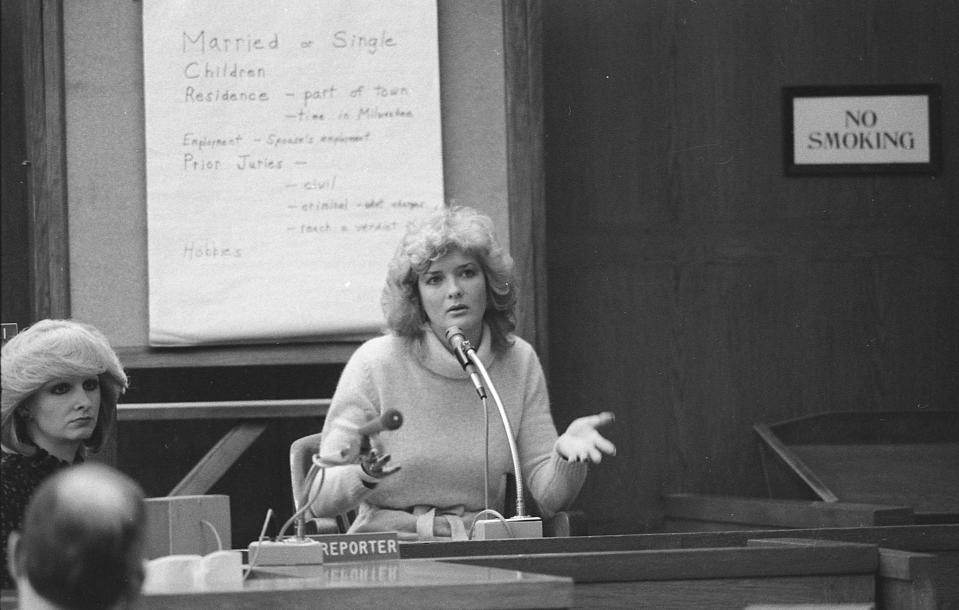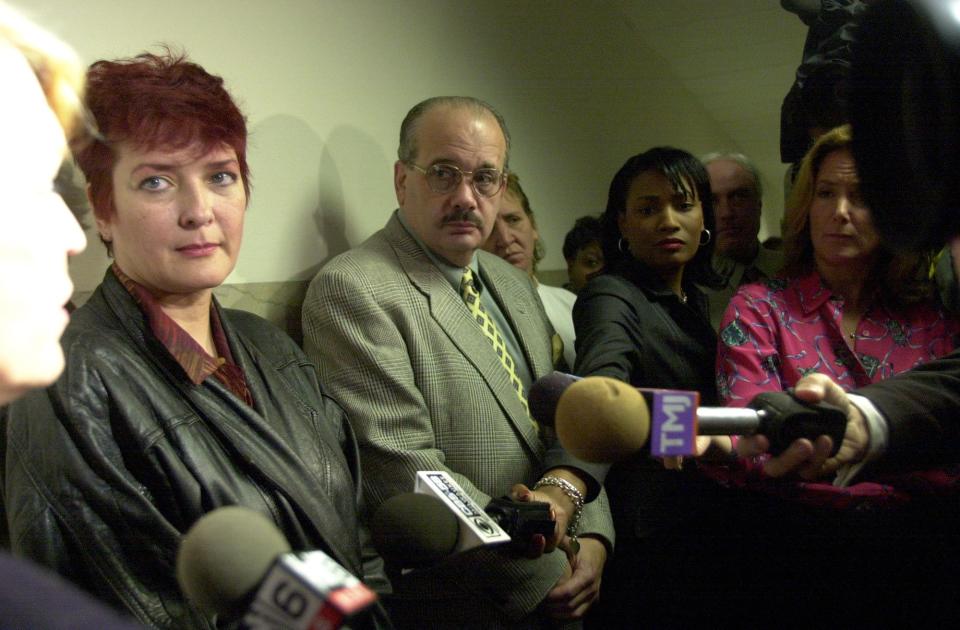What to know about Lawrencia "Bambi" Bembenek, her murder conviction and prison escape
Milwaukee native Lawrencia Bembenek, who was convicted of murder in 1982, fought the verdict and protested her innocence until she died. Her life story, which included a dramatic escape from prison and flight to Canada, has a "folkloric" feel, "like a Bonnie and Clyde or Pretty Boy Floyd story," said Milwaukee playwright Eric Simonson, who wrote the musical "Run Bambi Run."
Bembenek had many supporters who believed in her innocence and criticized actions of the Milwaukee Police Department. Her case has been re-argued and her story has been retold in TV specials, podcasts and plays.
Here is a primer of the facts and disputed elements of her story.
Who was Lawrencia Bembenek?
Born in 1958, Bembenek grew up on Milwaukee's south side and attended Catholic schools before graduating from Bay View High School. She earned an associate degree in fashion merchandising management from Bryant & Stratton College in Virginia Beach, Virginia. She then returned to Milwaukee, working briefly in retail and as a model.
In 1980, she graduated from the Milwaukee Police Academy and was assigned to the south side. But during her probationary period, she was fired. In the wake of that disputed event, she filed a sex discrimination complaint against the department. Bembenek worked for a short time as a waitress at the Playboy Club in Lake Geneva, which she later ruefully said always showed up in stories about her.
Later in life, she changed her first name from Lawrencia to Laurie.
What crime was Bembenek accused of?
She married Milwaukee Police officer Elfred Schultz in January 1981, less than three months after Schultz divorced his first wife, Christine. On May 28 of that year, Christine was found murdered. She had been tied and gagged in her home and fatally shot, according to court testimony.
Bembenek was arrested for the murder on June 24, 1981.

What happened at Bembenek's murder trial?
Court testimony indicated that Christine Schultz was killed with her ex-husband's service revolver.
Bembenek claimed she was being framed for the murder, possibly because of her complaint against the police department.
"The largely circumstantial case was enough to convince a jury. Testimony included details of a hair-like fiber near the body," the Journal Sentinel reported in its 2010 obituary of Bembenek. "That fiber was considered a match with a reddish-brown wig found in plumbing in the apartment building where Bembenek and Elfred Schultz had been living."
What evidence do supporters cite in favor of Bembenek?
Supporters cite the testimony of Christine Schultz's preteen son Sean, who saw a masked intruder in their home the night of the murder. Sean said the intruder was a man with a red ponytail.
Critics also point out that Elfred Schultz, who would have had to have been considered an initial suspect in an investigation of his ex-wife's murder, was allowed to be on the crime scene and search the house.
What was the verdict in Bembenek's murder trial?
On March 9, 1982, she was found guilty of first-degree murder and sentenced to life in prison. Bembenek was sent to Taycheedah Correctional Institute in Fond du Lac.
How did Bembenek escape from prison?
On July 15, 1990, Bembenek escaped through a laundry room window at Taycheedah and was picked up by her fiancé Dominic Gugliatto, the brother of a fellow inmate. They fled to Canada.
Her escape drew enormous publicity, including a segment on the TV show "America's Most Wanted." During this time, the "Run, Bambi, Run" slogan showed up on T-shirts.
On Oct. 17, 1990, Bembenek and Gugliatto were arrested in Thunder Bay, Ontario, by Canadian immigration authorities after a tourist recognized them from the "Amerca's Most Wanted" episode.
Gugliatto was deported to the U.S. on Nov. 16, 1990, convicted of aiding in Bembenek's escape and served 3-1/2 months in Fond du Lac County Jail.
Why did Bembenek return to the U.S. from Canada?
After her arrest in Canada, Bembenek asked to be admitted as a political refugee and a victim of sexual discrimination. In June 1991, authorities in Canada began a full hearing on her possible refugee status.
The U.S., of course, requested her extradition. Canadian authorities asked for a commitment that the case would be reviewed.
On Oct. 14, 1991, Milwaukee County Circuit Judge William J. Haese opened a John Doe inquiry into whether there was criminal wrongdoing in the investigation or prosecution of the Christine Schultz murder case.
Bembenek voluntarily returned to the U.S. While the John Doe probe did not find evidence of wrongdoing by the police or prosecutors, it did point out a number of police mistakes in the investigation. She received the right to a new trial.
In what her Journal Sentinel obituary called a "complicated deal," she agreed to plead no contest to second-degree murder during a hearing on Dec. 9, 1992. She was sentenced to 20 years, which was commuted to time served. She was released from custody later that day.

What did Bembenek do with the rest of her life?
She maintained her innocence and pursued every legal means to be exonerated, often with help from private investigator Ira B. Robins.
In perhaps the most bizarre episode of this bizarre story, Bembenek agreed to appear on the "Dr. Phil" show in 2002; the show had agreed to pay for expensive testing of murder scene evidence for her DNA. Show producers kept Bembenek in an apartment with a bodyguard, apparently to shield her from media reports, her lawyer said. Bembenek had a panic attack and flashback to prison confinement, and she tried to climb out of a window, the lawyer said. She fell and injured her right foot, which later had to be amputated.
Bembenek moved to Washington state in 1996 to be near her retired parents, who lived in Vancouver. She returned to painting, a youthful passion, and had a gallery show, but a fire at the gallery destroyed her paintings.
Health problems that included hepatitis C and liver and kidney failure shortened her life. She died in hospice care in Portland, Oregon, on Nov. 21, 2010, at age 52.
What plays, books and movies have retold the Bembenek story?
There are many explorations and reconsiderations of the Bembenek story in popular media. Here are a few of the notable ones.
True-crime cable channel Investigation Discovery premiered an episode about the Bembenek case, titled "Run Bambi Run," on Feb. 5, 2024, in its series "The Playboy Murders."
The newest local retelling is Milwaukee Repertory Theater's world premiere rock musical, "Run Bambi Run," written by Eric Simonson with songs written and composed by Violent Femmes voice Gordon Gano. Performances took place Sept. 13-Oct, 22, 2023.
Apple TV+ posted Vanessa Grigoriadis' podcast series "Run, Bambi, Run" in 2022. It is still available on podcast sites.
Kris Radish's 1992 book, "Run, Bambi, Run," based on interviews with Bembenek, was a major source for the 2022 podcast and continues to be a resource for creators and people fascinated by this case.
Bembenek wrote her own book, "Woman on Trial," also published in 1992. It appears to be out of print, but is available in the Milwaukee County library system, and used copies are on sale at online vendors.
Two made-for-TV movies about Bembenek appeared in the early '90s: "Calendar Girl, Cop, Killer? The Bambi Bembenek Story" (1992), starring Lindsay Frost as Bembenek; and "Woman on the Run: The Lawrencia Bembenek Story" (1993), starring Tatum O'Neal in the title role.
In 1991, the Performing Arts Center (now known as the Marcus Performing Arts Center) staged "Bembenek: After the Verdict," a play written by Dale Gutzman and Bill Roddick, the latter a paralegal who had worked for Bembenek's attorneys and who had written his own book on the case.
Sources: Milwaukee Journal Sentinel archives; "Laurie's Last Days" by Erik Gunn, posted June 21, 2011, at MilwaukeeMag.com; "The Crime Scene" by Katherine Ramsland, crimelibrary.org/criminal_mind/forensics/crimescene/1.html.
This article originally appeared on Milwaukee Journal Sentinel: Lawrencia "Bambi" Bembenek case file: Facts and disputed elements

